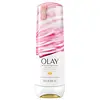What's inside
What's inside
 Key Ingredients
Key Ingredients

 Benefits
Benefits

 Concerns
Concerns

 Ingredients Side-by-side
Ingredients Side-by-side

Water
Skin ConditioningPetrolatum
EmollientSodium Trideceth Sulfate
CleansingParaffinum Liquidum
EmollientSodium Chloride
MaskingGlycine Soja Oil
EmollientCocamidopropyl Betaine
CleansingParfum
MaskingTrideceth-3
EmulsifyingNiacinamide
SmoothingSodium Citrate
BufferingGuar Hydroxypropyltrimonium Chloride
Skin ConditioningSodium Benzoate
MaskingXanthan Gum
EmulsifyingCitric Acid
BufferingDisodium EDTA
BHT
AntioxidantGlyceryl Oleate
EmollientAcrylates/C10-30 Alkyl Acrylate Crosspolymer
Emulsion StabilisingButyrospermum Parkii Butter
Skin ConditioningMethylchloroisothiazolinone
PreservativeMethylisothiazolinone
PreservativeCI 15850
Cosmetic ColorantWater, Petrolatum, Sodium Trideceth Sulfate, Paraffinum Liquidum, Sodium Chloride, Glycine Soja Oil, Cocamidopropyl Betaine, Parfum, Trideceth-3, Niacinamide, Sodium Citrate, Guar Hydroxypropyltrimonium Chloride, Sodium Benzoate, Xanthan Gum, Citric Acid, Disodium EDTA, BHT, Glyceryl Oleate, Acrylates/C10-30 Alkyl Acrylate Crosspolymer, Butyrospermum Parkii Butter, Methylchloroisothiazolinone, Methylisothiazolinone, CI 15850
Salicylic Acid 2%
MaskingAcrylates Copolymer
Agar
MaskingAscorbyl Palmitate
AntioxidantBenzalkonium Chloride
AntimicrobialButylene Glycol
HumectantC12-15 Alkyl Lactate
EmollientCamellia Oleifera Leaf Extract
AstringentCarrageenan
Chamomilla Recutita Flower Extract
MaskingCitrus Grandis Fruit Extract
AstringentCocamidopropyl Betaine
CleansingCocamidopropyl Pg-Dimonium Chloride Phosphate
Disodium EDTA
Glycerin
HumectantIron Oxides
Mica
Cosmetic ColorantParfum
MaskingPolyquaternium-7
Polysorbate 20
EmulsifyingPropylene Glycol
HumectantCI 73360
Cosmetic ColorantCI 16035
Cosmetic ColorantSodium Benzotriazolyl Butylphenol Sulfonate
UV AbsorberSodium C14-16 Olefin Sulfonate
CleansingSodium Hydroxide
BufferingTitanium Dioxide
Cosmetic ColorantCI 60725
Cosmetic ColorantWater
Skin ConditioningSalicylic Acid 2%, Acrylates Copolymer, Agar, Ascorbyl Palmitate, Benzalkonium Chloride, Butylene Glycol, C12-15 Alkyl Lactate, Camellia Oleifera Leaf Extract, Carrageenan, Chamomilla Recutita Flower Extract, Citrus Grandis Fruit Extract, Cocamidopropyl Betaine, Cocamidopropyl Pg-Dimonium Chloride Phosphate, Disodium EDTA, Glycerin, Iron Oxides, Mica, Parfum, Polyquaternium-7, Polysorbate 20, Propylene Glycol, CI 73360, CI 16035, Sodium Benzotriazolyl Butylphenol Sulfonate, Sodium C14-16 Olefin Sulfonate, Sodium Hydroxide, Titanium Dioxide, CI 60725, Water
 Reviews
Reviews

Ingredients Explained
These ingredients are found in both products.
Ingredients higher up in an ingredient list are typically present in a larger amount.
Cocamidopropyl Betaine is a fatty acid created by mixing similar compounds in coconut oil and dimethylaminopropylamine, a compound with two amino groups.
This ingredient is a surfactant and cleanser. It helps gather the dirt, pollutants, and other impurities in your skin to be washed away. It also helps thicken a product and make the texture more creamy.
Being created from coconut oil means Cocamidopropyl Betaine is hydrating for the skin.
While Cocamidopropyl Betaine was believed to be an allergen, a study from 2012 disproved this. It found two compounds in unpure Cocamidopropyl Betaine to be the irritants: aminoamide and 3-dimethylaminopropylamine. High-grade and pure Cocamidopropyl Betaine did not induce allergic reactions during this study.
Learn more about Cocamidopropyl BetaineDisodium EDTA plays a role in making products more stable by aiding other preservatives.
It is a chelating agent, meaning it neutralizes metal ions that may be found in a product.
Disodium EDTA is a salt of edetic acid and is found to be safe in cosmetic ingredients.
Learn more about Disodium EDTAParfum is a catch-all term for an ingredient or more that is used to give a scent to products.
Also called "fragrance", this ingredient can be a blend of hundreds of chemicals or plant oils. This means every product with "fragrance" or "parfum" in the ingredients list is a different mixture.
For instance, Habanolide is a proprietary trade name for a specific aroma chemical. When used as a fragrance ingredient in cosmetics, most aroma chemicals fall under the broad labeling category of “FRAGRANCE” or “PARFUM” according to EU and US regulations.
The term 'parfum' or 'fragrance' is not regulated in many countries. In many cases, it is up to the brand to define this term.
For instance, many brands choose to label themselves as "fragrance-free" because they are not using synthetic fragrances. However, their products may still contain ingredients such as essential oils that are considered a fragrance by INCI standards.
One example is Calendula flower extract. Calendula is an essential oil that still imparts a scent or 'fragrance'.
Depending on the blend, the ingredients in the mixture can cause allergies and sensitivities on the skin. Some ingredients that are known EU allergens include linalool and citronellol.
Parfum can also be used to mask or cover an unpleasant scent.
The bottom line is: not all fragrances/parfum/ingredients are created equally. If you are worried about fragrances, we recommend taking a closer look at an ingredient. And of course, we always recommend speaking with a professional.
Learn more about ParfumWater. It's the most common cosmetic ingredient of all. You'll usually see it at the top of ingredient lists, meaning that it makes up the largest part of the product.
So why is it so popular? Water most often acts as a solvent - this means that it helps dissolve other ingredients into the formulation.
You'll also recognize water as that liquid we all need to stay alive. If you see this, drink a glass of water. Stay hydrated!
Learn more about Water